
Search Wild Foods Home Garden & Nature's Restaurant Websites:
Hazelnuts
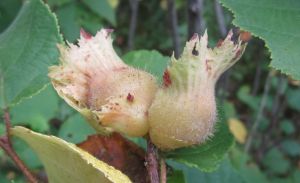
(NOTE: If you are not interested in growing Hazelnuts, but just finding them, try going to the Nature's Restaurant Online site for Hazelnuts.)
The Beaked Hazelnut (Corylus cornuta) and the American Hazelnut (Corylus americana). Similar in flavor to the commercial Hazelnut or Filbert, but even better, though they are smaller. They are shrubs, and can be very large shrubs, most often found on the edges of woods and openings in woods. Very good food producing, and nice looking border shrub, or a shrub for the center of the yard. This is a really nice looking shrub in the fall as well.
Seeds: You can grow them from seed. Most people suggest starting them in pots, but I suggest planting them where you want them. In the fall gather the nuts off the shrubs, and using a file or rasp, take off a little of the outer part of the shell, but don't go all the way through - just enough so you see lighter sections where you file. Soak in water for a day, and plant the ones that don't float about 2.5-5 cm (1-2 inches) deep where you want them. Make sure the soil is ready first. Cover with mulch, and leave. I also suggest taking some action so the squirrels don't dig them back up - read the Black Walnut section for ideas. In the spring, don't let the area where they are planted dry out.
Transplanting: Often if you find one of these shrubs, there will be many around, and transplanting a small one is a good way to start. Transplant when dormant after leaves fall in late fall or before buds open in spring. If transplanting a root sucker, best to do it in early spring. You only need one as they are self-pollinating.
Soil & Site: This shrub can grow in a wide variety of conditions, but for best production of the nuts, there are a couple of counter intuitive requirements. One, you don't want rich, fertile soil - you want light, sandy soil that is not too full of nutrients. If it is too rich, the plant will grow very well, but not produce a big crop of nuts. The next requirement is there is some shading. Not dark shade in a woods, but think of where it naturally grows - the edges of woods. Some sun time, some shade time, some dappled sunlight time. The soil needs to be slightly acidic to slightly alkaline - just what you would expect in and around a deciduous woods.
Planting: The next consideration is how to grow them. You can grow them as individual shrubs or in rows. If you choose rows, keep them 2-3 meters (6-10 feet) apart per shrub, and if you have more than one row, keep those 3-4 meters (10-13 feet) apart. Before you even plant them, till the area a few times to kill off any weeds, and after planting mulch the area to keep the weeds down. If you are planting one or two transplants, mowing around them should do the trick. You can buy them bare rooted or in pots. The bare rooted are a much lower price. Follow the instructions given by the grower for planting.
Maintenance: Make sure the roots do not dry out in the first year after transplanting, and other than keeping the suckers back, prune out any sick or dead branches, and keep it from getting too dense. They can get very tall, so if you are growing them to gather the nuts, I'd suggest keeping them down to a size you can reach. They will spread by suckers to fill out in between, and that is great if you are looking for a great looking hedge, but if you want the most nut production, you will be best to mow or prune out any of the suckers that spread by the roots. In the first few years, it is important to keep the weeds down around them.
Harvesting: In the fall, gather when the hairy, thin husks turn from green to yellow, red or brown. See the pictures below the description to see what they look like when ripe. Many people find the hairs on the outer husk irritating to the skin, as they can dig in, so you should use gloves when dealing with them.
Using: Once the outer husk is removed, you can save them and use them just like the commercially grown Filberts. They crack with a regular nutcracker, and can also be used in baked goods. If the meat in the nut looks shrivelled, don't eat.
Recipe search on the web here (Google search) and here (Bing search).
Beaked Hazelnut (Corylus cornuta):
Description:
- USDA Plant Hardiness Zone: 4-8 (More information on hardiness zones).
- Soil pH: 6.0-7.5
- Plant Size: Up to 8 meters (26 feet) tall, though usually shorter than that. Often found in groups
- Duration: Perennial Shrub
- Leaf Shape: Close to round Ovate
- Leaf Phyllotaxis (Arrangement) on branch: Alternate
- Leaf Size: 5–11 cm (2 to 4 1/3 inches) long and 3–8 cm (1 1/5 to 3 inches) wide
- Leaf Margin: Double Serrated (saw toothed edge)
- Leaf Notes: Leaf underside is hairy
- Flowers: Male: long, narrow multi-flowered catkins that hang from branches, form in the fall. Female: short red flowers
- Fruit: A nut that looks like the commercially grown Filbert but smaller, in a thin husk that is hairy and extends outward up to 4 cm (1 1/2 inches) forming what looks like a beak - hence the name
- Bark: Smooth, grey, young twigs are reddish to green and covered with hairs
- Habitat: Drier areas, edges of woods and openings in woods
Web Resources:
- Pictures on the web here (Google images) and here (Bing images).
- Interactive USDA distribution map and plant profile here.
- The Biota of North America Program (BONAP) distribution map here. BONAP map color key here.

The Beaked Hazelnut (Corylus cornuta) range. Distribution map courtesy of U. S. Department of Agriculture (USDA Natural Resources Service) and used in accordance with their policies.
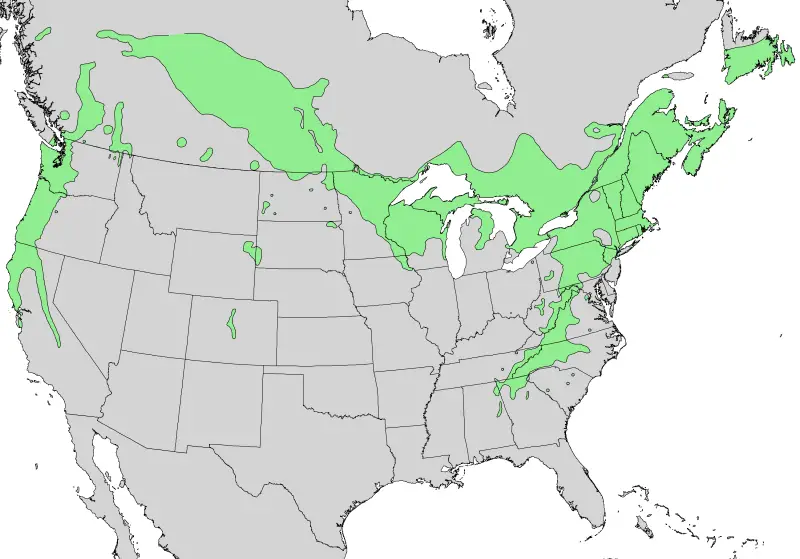
The Beaked Hazelnut (Corylus cornuta) range. Distribution map courtesy of the USGS Geosciences and Environmental Change Science Center, originally from "Atlas of United States Trees" by Elbert L. Little, Jr. .
American Hazelnut (Corylus americana):
Description:
- USDA Plant Hardiness Zone: 4-9 (More information on hardiness zones).
- Soil pH: 6.1-7.8
- Plant Size: Generally up to 3 meters (10 feet) tall as a shrub, but on occasion can grow larger when it takes a small tree form
- Duration: Perennial Shrub, though occasionally is found as a small tree
- Leaf Shape: Broad Ovate
- Leaf Phyllotaxis (Arrangement) on branch: Alternate
- Leaf Size: Up to 12.5 cm (5 inches) long
- Leaf Margin: Double Serrated (saw toothed edge)
- Leaf Notes: Upper side of leaf is dark green, underside is paler, stem is hairy and very often red
- Flowers: Male: long, narrow multi-flowered catkins that hang from branches, form in the fall. Female: short red flowers
- Fruit: Nuts mature in September to October. Thin husk, green, yellow, red and brown tones when ripe. Nut inside looks like commercially grown Filbert but is smaller. Brown with light tan end
- Bark: Young twigs covered in hairs, red. Older twigs brown. More mature branch bark is light grey and smooth.
- Habitat: Variety of habitats, but most common on edges of woods or openings in woods in deep, rich sandy loams.
Web Resources:
- Pictures on the web here (Google images) and here (Bing images).
- Interactive USDA distribution map and plant profile here.
- The Biota of North America Program (BONAP) distribution map here. BONAP map color key here.
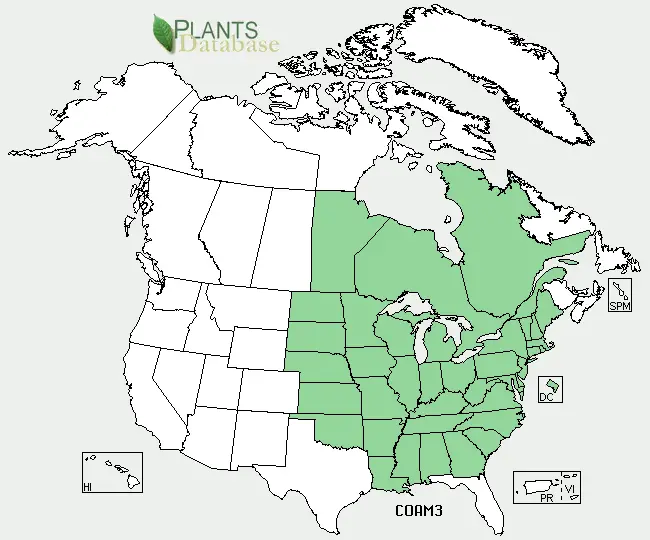
American Hazelnut (Corylus americana) range. Distribution map courtesy of U. S. Department of Agriculture (USDA Natural Resources Service) and used in accordance with their policies.
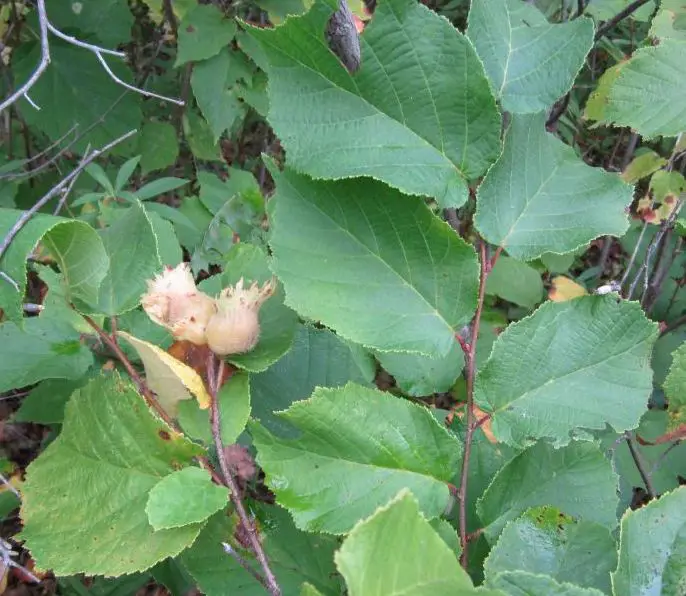
This is an American Hazelnut (Corylus americana) bush with two Hazelnuts on the end of a branch. This picture was taken in Mid September in South-Western Ontario along a trail after coming out of a forest. It is very common to find Hazelnuts on the edges of woods.

A close-up of the twigs and leaf stems of the American Hazelnut (Corylus americana).
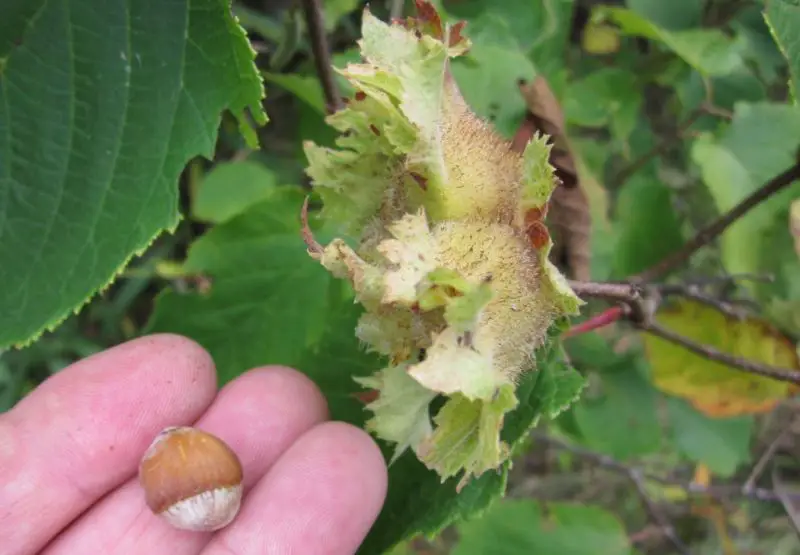
American Hazelnut (Corylus americana) just after being taken out of the husk to the right of my fingers.
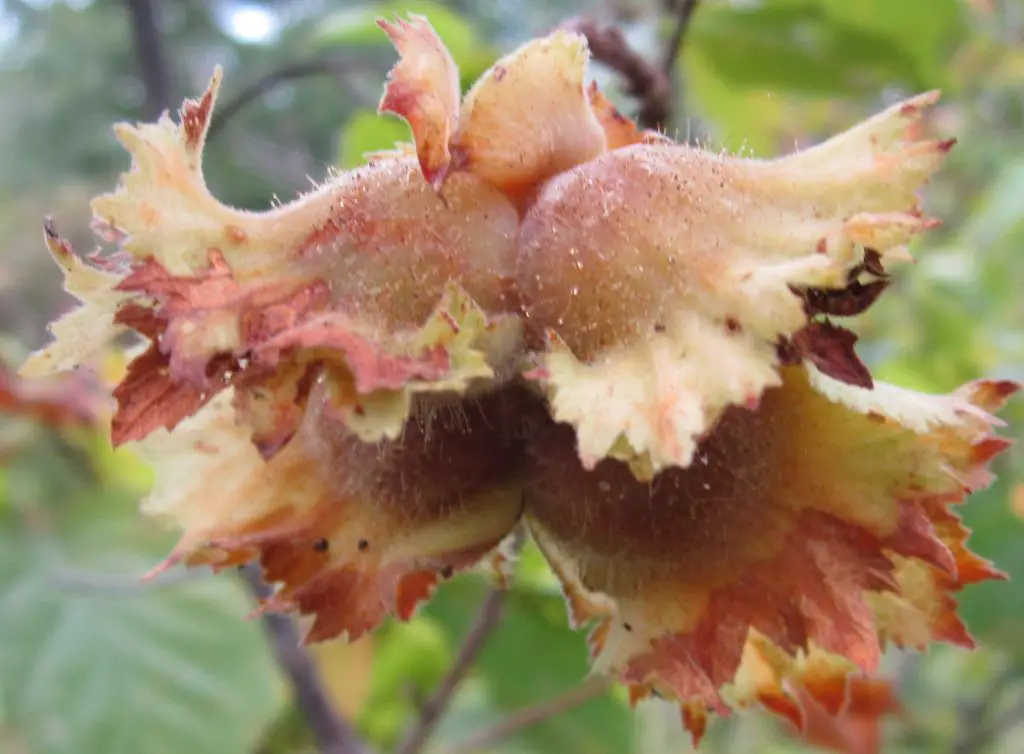
Ripe American Hazelnuts (Corylus americana). The color of the husk tells you when ripe. Husk would be green if not ripe.
Search Wild Foods Home Garden & Nature's Restaurant Websites:
Share:
Why does this site have ads?
Originally the content in this site was a book that was sold through Amazon worldwide. However, I wanted the information to available to everyone free of charge, so I made this website. The ads on the site help cover the cost of maintaining the site and keeping it available.
Google + profile
